Table of Contents
- What is MIG Welding?
- Brief History of MIG Welding
- 1. Advantages of MIG Welding for Mild Steel
- 2. Understanding Mild Steel
- 3. Equipment and Safety Measures
- 4. Preparing for MIG Welding
- 5. Basic MIG Welding Techniques
- 6. Executing MIG Welds on Mild Steel
- 7. Common Mistakes and Troubleshooting
- 8. Finishing Touches and Post-Welding Care
- 9. Applications and Projects
- 10. Tips for Improving MIG Welding Skills
- Conclusion
Welcome to the world of MIG welding for mild steel. Discover the fundamentals, advantages, and crucial techniques driving successful welds in this guide. Uncover the essence of MIG welding, its historical journey, and why it’s the go-to for mild steel. Let’s delve deeper into this essential welding art.
What is MIG Welding?
MIG (Metal Inert Gas) welding, also known as Gas Metal Arc Welding (GMAW), is a widely embraced welding technique in the metalworking industry. This method employs a continuous solid wire electrode fed through a welding gun, typically made of mild steel, aluminum, or stainless steel. Simultaneously, an inert gas, such as argon or a mixture of argon and carbon dioxide, shields the weld pool from atmospheric contamination during the fusion process.
MIG welding derives its efficiency from its ability to provide a controlled arc and a consistent weld bead. The wire electrode is a filler material that conducts the electrical current to form the weld. As the wire melts and fuses with the base metals, it creates a sturdy, durable joint.
Brief History of MIG Welding
The genesis of MIG welding dates back to the 1940s when P.O. Nobel and H. Granjon first introduced the concept. However, it wasn’t until the 1950s that the process gained significant traction, primarily in the manufacturing and fabrication sectors. Over time, advancements in technology and equipment have refined the MIG welding process, making it more versatile, user-friendly, and widely applicable across various industries.
MIG welding’s evolution has led to the development of specialized machines, consumables, and shielding gases tailored to different applications and metal types. Its adaptability to different welding positions and materials, including mild steel, aluminum, and stainless steel, has contributed to its prevalence as a go-to welding method for professionals and hobbyists.
MIG welding’s continuous innovation and versatility are pivotal in the modern fabrication landscape, enabling precise and efficient metal joining for various projects, from automotive manufacturing to structural construction.
1. Advantages of MIG Welding for Mild Steel
Versatility in Application
MIG welding offers remarkable versatility, mainly when working with mild steel. Its adaptability spans various thicknesses of soft steel sheets, making it an ideal choice for diverse projects. Whether intricate welding on thin mild steel plates or joining thicker sections, MIG welding showcases its efficacy across the spectrum.
The ability to weld in multiple positions—flat, horizontal, vertical, and overhead—further enhances its utility. This versatility allows welders to maneuver comfortably and execute precise welds in different orientations, accommodating the demands of various fabrication tasks.
Speed and Efficiency
When applied to mild steel, one of the standout features of MIG welding is its efficiency in swiftly completing welding tasks. The continuous wire feeding mechanism and the controlled arc facilitate a faster welding process than traditional methods. This attribute makes MIG welding exceptionally advantageous for large-scale projects where time efficiency is paramount.
The rapid deposition rate, enabled by continuous wire feeding, ensures quick coverage of large surface areas, reducing project timelines. This speed increases productivity and minimizes heat input into the material, reducing the risk of distortion or warping, which is especially crucial when working with mild steel.
The efficiency and speed of MIG welding for mild steel make it a preferred choice in industries where meeting production targets without compromising quality is imperative. Its ability to balance speed and precision elevates its significance in fabricating mild steel components for various applications.
2. Understanding Mild Steel
Characteristics of Mild Steel
Mild steel, also known as low-carbon steel, represents one of the most commonly used materials in welding due to its favorable properties. Its composition primarily comprises iron and a low percentage of carbon, usually ranging from 0.05% to 0.25%. This low carbon content distinguishes mild steel from other types of steel, imparting several advantageous characteristics.
1. Ductility and Malleability: Mild steel exhibits excellent ductility and malleability, allowing it to be easily formed, shaped, and welded without significant risk of brittleness. This property makes it highly versatile for various fabrication applications.
2. Weldability: The low carbon content contributes to mild steel’s exceptional weldability. It fuses smoothly and cleanly during welding processes like MIG welding, producing strong and durable joints without compromising the material’s structural integrity.
3. Strength and Toughness: While mild steel may not possess the high tensile strength of some other steel types, it offers a commendable balance between power and toughness. This makes it suitable for a wide array of structural and industrial applications.
Suitability for MIG Welding
The composition of mild steel aligns harmoniously with the parameters of MIG welding. The welding process operates optimally with suitable weldability materials, making mild steel an excellent fit. The ease of fusion and the ability to form secure bonds without needing preheating or post-weld heat treatment make mild steel an ideal candidate for MIG welding.
The compatibility between MIG welding and mild steel extends beyond the welding process. Mild steel’s affordability, availability, and ease of manipulation contribute to its popularity in numerous industries, further reinforcing its suitability for MIG welding applications.
3. Equipment and Safety Measures
MIG Welding Machine Components
MIG welding necessitates specific equipment components to ensure a seamless welding process, especially when working with mild steel.
1. Power Source: The welding machine’s power source supplies the electrical current required for the welding process. Understanding the machine’s power specifications and adjusting settings according to the thickness of the mild steel being welded is crucial for optimal performance.
2. Wire Feeder: A wire feeder mechanism is an integral part of MIG welding machines and is responsible for delivering the electrode wire continuously. The consistent and controlled feeding of the wire ensures a steady arc and uniform weld bead formation.
3. Welding Gun: The welding gun serves as the conduit for the electrode wire and provides the necessary shielding gas to protect the weld pool. Different gun styles and nozzle sizes cater to various welding applications and preferences.
4. Shielding Gas: Shielding gas, often a combination of argon and carbon dioxide or pure argon, forms a protective atmosphere around the weld to prevent contamination from the surrounding air. The selection of the appropriate gas mixture depends on the specific mild steel being welded and the desired welding characteristics.
5. Ground Clamp: Ensuring a proper electrical connection between the welding machine and the workpiece, the ground clamp plays a vital role in completing the welding circuit.
Understanding the functionality and interplay of these components is essential for welders operating MIG welding machines for mild steel applications. Mastery of the machine’s settings and adjustments contributes significantly to achieving high-quality welds with minimal defects.
Safety Gear and Precautions
Like any welding process, MIG welding demands strict adherence to safety measures to mitigate potential hazards associated with the process and the materials involved.
1. Welding Helmet: A welding helmet with a protective lens shields the eyes and face from the intense arc light emitted during welding. Auto-darkening helmets offer added convenience by adjusting the lens darkness automatically.
2. Gloves and Protective Clothing: Welding gloves of durable, heat-resistant materials protect the hands from sparks, heat, and molten metal. Flame-resistant clothing, including a long-sleeved jacket and pants, safeguard the body from potential burns and sparks.
3. Ventilation and Fume Extraction: Adequate ventilation in the welding area is crucial to dissipate fumes and gases produced during welding. Fume extraction systems help remove harmful particles and gases from the workspace, ensuring a safer working environment.
Prioritizing safety through appropriate safety gear and ensuring a well-ventilated workspace significantly reduces the risks associated with MIG welding, promoting a safer and more secure welding experience.
4. Preparing for MIG Welding
Surface Cleaning and Preparation
Proper preparation of the metal surface before initiating the welding process is pivotal for achieving high-quality welds when working with mild steel.
1. Cleaning the Surface: Begin by removing any surface contaminants, such as rust, oil, paint, or dirt, using a wire brush, grinder, or chemical solvent. A clean surface ensures better weld penetration and minimizes the risk of defects in the final weld.
2. Material Inspection: Thoroughly inspect the mild steel material for any imperfections, cracks, or inconsistencies that might affect the welding process. It is addressing these issues before welding prevents potential complications during the fusion process.
Gas and Wire Selection
Selecting the appropriate shielding gas and wire diameter is crucial for successful MIG welding on mild steel.
1. Shielding Gas Selection: The choice of shielding gas depends on the specific mild steel composition and the desired welding characteristics. Argon, carbon dioxide, or a blend of both gases are commonly used for MIG welding mild steel. The gas mixture influences the weld penetration, arc stability, and bead appearance.
2. Wire Diameter and Type: The diameter and type of welding wire should align with the thickness of the mild steel being welded. Thinner wires work better for more delicate materials, while thicker wires suit thicker, gentle steel sections. Additionally, selecting the appropriate wire composition—such as ER70S-6 for general mild steel welding—ensures compatibility and quality welds.
Understanding the significance of surface preparation and the impact of gas and wire selection is crucial for welders embarking on MIG welding projects involving mild steel. The meticulousness applied during these preparatory steps significantly contributes to the overall quality and strength of the welded joint.
5. Basic MIG Welding Techniques
Setting Up the Machine
Before initiating the welding process on mild steel using MIG, it’s imperative to appropriately set up the welding machine.
1. Adjusting Voltage and Wire Feed Speed: Understanding the relationship between voltage and wire feed speed is crucial. Voltage settings regulate the heat input, while wire feed speed controls the rate at which the electrode wire is fed into the weld pool. Balancing these settings based on the mild steel’s thickness and welding requirements ensures optimal penetration and bead formation.
2. Gas Flow and Regulator Adjustment: Proper gas flow is critical for shielding the weld pool effectively. Adjust the gas flow rate using the regulator to maintain a consistent and adequate shielding environment around the welding area.
Correct Posture and Handling
We maintain the correct posture and handling techniques, while MIG welding significantly impacts the quality and precision of the welds.
1. Body Positioning: Stand comfortably with feet shoulder-width apart and maintain a stable posture to support balance and control during welding. Avoid leaning excessively toward the weld area to prevent fatigue and ensure better control over the welding gun’s movement.
2. Holding the Welding Gun: Hold the welding gun with a relaxed grip and a steady hand. Position the gun at the correct angle and distance from the workpiece to achieve the desired penetration and weld bead appearance. Practice regular and consistent movement to ensure uniform weld deposition.
Mastering the foundational techniques of setting up the welding machine and adopting proper posture and handling techniques is fundamental for welders embarking on MIG welding projects with mild steel. These skills lay the groundwork for executing precise and controlled welds, contributing to the overall quality and integrity of the welded joints.
6. Executing MIG Welds on Mild Steel
Welding Positions and Angles
Understanding and adapting to different welding positions and angles is crucial for achieving consistent and structurally sound welds when working with mild steel using MIG welding techniques.
1. Flat Position: Welding in the flat position, where the workpiece is horizontal, is often the easiest. Maintain a consistent travel speed and maintain the gun angle to achieve a smooth and even weld bead.
2. Horizontal Position: Welding in the horizontal position, where the workpiece is placed sideways, requires slightly different techniques. Adjust the travel speed and gun angle to ensure proper fusion and avoid excessive weld sagging or undercutting.
3. Vertical Position: Welding in the vertical position, either upwards or downwards, demands precision. Control the weld pool by manipulating the gun angle and adjusting the travel speed to prevent excessive drips or insufficient fusion.
4. Overhead Position: Welding overhead, where the workpiece is positioned above the welder, demands exceptional control and technique. Maintain a steady hand, control the molten pool, and adjust the travel speed to prevent excessive spatter and achieve full penetration.
Controlling the Weld Pool
Mastering the control of the weld pool is paramount for producing clean and structurally sound welds on mild steel using MIG welding.
1. Travel Speed: The speed at which the welding gun moves along the joint affects weld penetration and bead appearance. Adjust the travel speed according to the welding position and material thickness to achieve the desired weld quality.
2. Gun Angle and Manipulation: The angle at which the welding gun is held relative to the workpiece determines the direction and shape of the weld bead. Manipulate the gun angle to control the molten pool’s size and shape, ensuring proper fusion and uniformity.
Practicing and mastering welding techniques in various positions and angles allow welders to adapt to diverse welding scenarios when working with mild steel. Proficiency in controlling the weld pool contributes significantly to achieving consistent and high-quality welds across different welding positions.
7. Common Mistakes and Troubleshooting
Overheating and Spatter Issues
Despite its efficiency, MIG welding on mild steel can encounter common issues affecting weld quality. Addressing these issues promptly through troubleshooting techniques ensures smoother welding processes.
1. Overheating: Excessive heat during welding can lead to distortion, warping, and weakened welds in mild steel. Adjust the voltage and wire feed speed to maintain an appropriate heat input for the material thickness to prevent overheating. Additionally, consider using a shorter welding arc to minimize heat concentration.
2. Spatter: Spatter, the unwanted splattering of molten metal droplets, often mars the appearance of the weld and requires post-weld cleanup. Controlling the gas flow rate, ensuring proper wire stick-out length, and adjusting the wire feed speed can help minimize spatter. An anti-spatter spray or a spatter-reducing solution to the workpiece surface can also mitigate this issue.
Rectifying Inconsistent Welds
Weld inconsistencies, such as incomplete fusion or irregular bead formation, are common challenges in MIG welding on mild steel. Troubleshooting these issues involves understanding their root causes and implementing corrective measures.
1. Adjusting Machine Settings: Inconsistent welds can result from incorrect machine settings. Ensure the voltage, wire feed speed, and gas flow rate are appropriate for the mild steel thickness and welding conditions. Fine-tuning these settings can rectify issues like incomplete fusion or irregular bead appearance.
2. Technique Adjustment: Inadequate welding techniques, such as improper gun angle, travel speed, or manipulation of the weld pool, can lead to inconsistencies. Practice proper design and make necessary adjustments to achieve uniform and structurally sound welds.
Addressing common mistakes and troubleshooting issues encountered during MIG welding on mild steel requires technical knowledge and practical skills. Identifying these challenges early and applying effective troubleshooting techniques contribute to consistent and high-quality welds.
8. Finishing Touches and Post-Welding Care
Cleaning the Welded Area
Post-weld cleaning is essential to ensure the weld area’s integrity and appearance after MIG welding on mild steel.
1. Removal of Slag and Spatter: Use a wire brush or grinder to remove any slag or spatter on the welded area. This step enhances the weld’s aesthetic appeal and prepares the surface for further treatment or inspection.
2. Surface Smoothing: Grinding the welded area to smoothen rough edges or uneven surfaces improves the final appearance and ensures a seamless transition between the welded joint and the base material.
Inspection and Maintenance
Thorough inspection and maintenance of the welded area are crucial for assessing weld quality and ensuring long-term durability.
1. Visual Inspection: Examine the weld bead for any signs of cracks, incomplete fusion, or irregularities. Ensure the weld’s conformity to desired specifications and standards.
2. Structural Integrity Check: Conduct non-destructive testing methods, if necessary, to evaluate the weld’s structural integrity. Ultrasonic testing or dye penetrant inspection helps identify potential defects or discontinuities.
3. Post-Weld Heat Treatment (if applicable): Depending on the application and specific requirements, consider performing post-weld heat treatment to relieve residual stresses and enhance the weld’s mechanical properties.
Regular maintenance of the welding equipment, such as cleaning the welding gun and replacing worn-out components, ensures continued reliability and optimal performance during subsequent welding sessions.
Adhering to proper post-welding care and inspection protocols guarantees the weld’s quality, durability, and adherence to industry standards, ensuring it meets the intended functional and structural requirements.
9. Applications and Projects
DIY Projects with Mild Steel Welding
MIG welding with mild steel opens up possibilities for engaging and creative do-it-yourself (DIY) projects.
1. Metal Furniture: Crafting furniture pieces such as tables, chairs, or shelving units using mild steel offers durability and a modern industrial aesthetic. MIG welding enables the joining of various steel components to create sturdy and customized furniture pieces.
2. Artistic Sculptures: Mild steel’s malleability allows artists to sculpt intricate and expressive forms. MIG welding techniques aid in assembling and shaping steel components, facilitating the creation of artistic sculptures with intricate details.
3. Automotive Repairs and Fabrication: MIG welding plays a significant role in repairing or fabricating automobile components, including exhaust systems, frames, or body panels. Its versatility allows for precise and robust welds on automotive-grade mild steel.
Industrial Applications
MIG welding on mild steel is indispensable for fabricating various structures and components in different industrial sectors.
1. Structural Construction: Mild steel, with its weldability and strength, is a primary material for constructing buildings, bridges, and infrastructure. MIG welding ensures reliable and durable connections between structural members, ensuring structural integrity.
2. Manufacturing and Fabrication: Industries rely on MIG welding for assembling machinery, equipment, and industrial components made from mild steel. The efficiency and speed of MIG welding contribute to increased productivity in manufacturing processes.
Versatility and Practicality
The versatility of MIG welding with mild steel extends across many applications, from artistic pursuits to heavy-duty industrial projects. Its adaptability to various welding positions and the ease of working with mild steel make it a preferred choice in DIY endeavors and professional settings.
The practicality of MIG welding on mild steel lies in its ability to offer durable and reliable welds, facilitating the creation of functional, aesthetically pleasing, and structurally sound products across diverse applications.
Understanding the diverse range of applications for MIG welding on mild steel allows welders to explore and leverage its potential in crafting innovative, functional, and enduring creations across various domains.
10. Tips for Improving MIG Welding Skills
Practice and Experimentation
1. Consistent Practice: Like any skill, mastering MIG welding with mild steel requires consistent practice. Regular practice sessions help refine welding techniques, improve control, and enhance overall proficiency.
2. Experimenting with Settings: Explore different machine settings, such as voltage, wire feed speed, and gas flow rates, to understand their impact on weld characteristics. Experimentation allows for a better grasp of how adjustments influence the weld quality.
Seeking Guidance and Resources
1. Learning Resources: Explore welding manuals, online tutorials, and instructional videos that provide insights into MIG welding techniques and troubleshooting methods. Online forums and communities also offer a platform to seek advice and learn from experienced welders.
2. Mentorship and Classes: Consider seeking mentorship from seasoned welders or enrolling in welding classes or workshops. Direct guidance and feedback from experienced professionals accelerate learning and skill development in MIG welding.
Continuous Learning and Adaptation
1. Embrace Challenges: Approach challenging welding projects as opportunities to learn and improve. Embracing challenges fosters growth and expands skill proficiency in handling diverse welding scenarios.
2. Keep Updated: Stay updated with the latest advancements, techniques, and equipment in MIG welding. Continuous learning and adaptation to new methodologies contribute to staying at the forefront of the welding industry.
Patience and Persistence
1. Patience in Learning: MIG welding proficiency develops over time with dedication and patience. Acknowledge that improvement comes through consistent effort and gradual skill refinement.
2. Persistence: Overcoming initial challenges and setbacks is part of learning. Persistence in practice and learning from mistakes pave the way toward mastery in MIG welding.
Adopting a proactive approach that combines consistent practice, seeking guidance, embracing challenges, and maintaining patience and persistence accelerates skill development and proficiency in MIG welding techniques for mild steel.
Conclusion
In conclusion, mastering MIG welding for mild steel entails a journey of exploration, practice, and continual learning. The versatility of this welding technique offers a gateway to diverse applications, from crafting intricate DIY projects to contributing to substantial industrial endeavors.
Understanding the nuances of mild steel properties and adeptness in equipment setup, welding techniques, and troubleshooting pave the way for creating robust and visually appealing welds. Embracing the art and science of MIG welding on mild steel empowers welders to unleash their creativity, construct durable structures, and contribute to various projects across various sectors.
With dedication, patience, and a commitment to honing skills, MIG welding becomes not just a technical skill but a medium for transforming ideas into tangible, enduring creations.
Is MIG welding suitable for all types of steel?
MIG welding is versatile but may require adjustments for different steel types.
Can I weld thick and thin mild steel sheets using MIG welding?
Yes, MIG welding can handle various thicknesses of mild steel effectively.
What safety gear is essential for MIG welding?
Essential safety gear includes a welding helmet, gloves, and flame-resistant clothing.
How can I avoid weld spatter during MIG welding?
Proper machine settings and technique adjustment can minimize spatter.
Is MIG welding easy to learn for beginners?
With practice and guidance, beginners can grasp MIG welding techniques effectively.
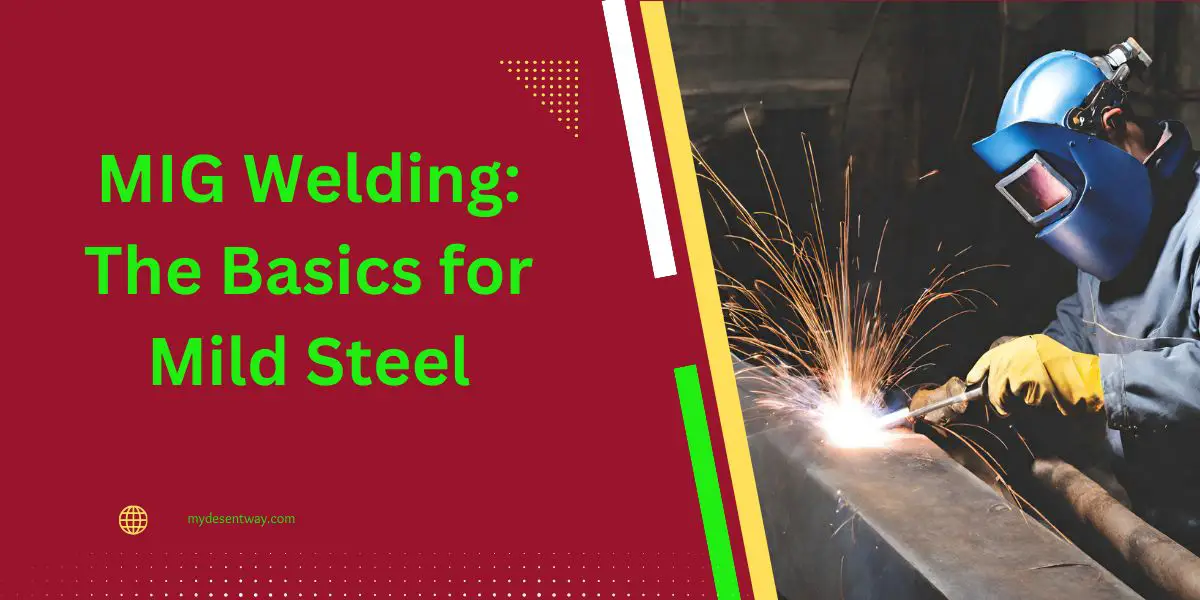
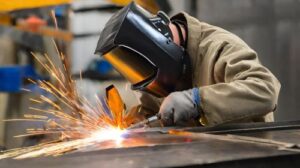
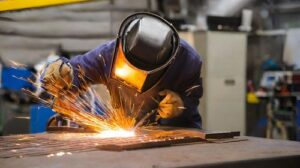

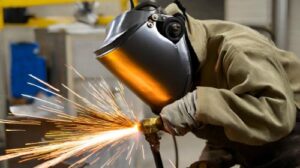

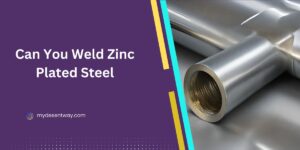






4 thoughts on “MIG Welding: The Basics for Mild Steel”